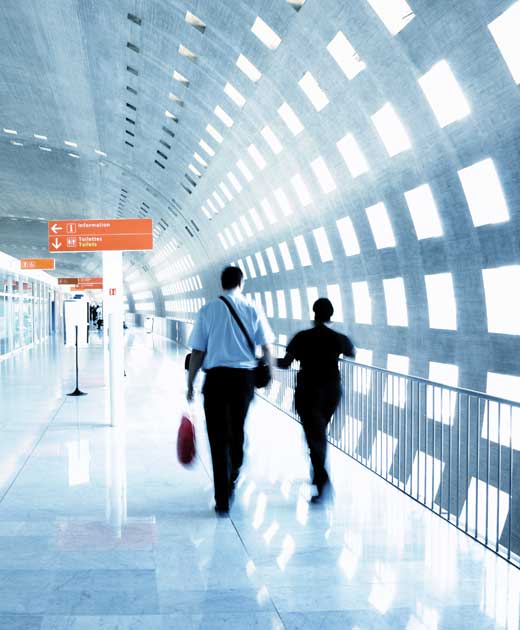
In today’s digital age, travel managers have more power than ever to measure the success of their corporate travel program. At the click of a button, it’s possible to access travel itinerary details, supplier information, airfare costs, and a variety of other areas where large volumes of data exist.
But numbers, tables and charts in themselves prove nothing. To demonstrate improvement over time, travel managers need to establish Key Performance Indicators (KPIs) and use data smartly in order to monitor progress against them. Here are the corporate travel KPIs you should consider to measure the success of your business travel program:
- Use of approved booking channels
- Traveller compliance with policy
- Supplier contract savings
- Traveller satisfaction and safety
- Carbon emissions
Spend and corporate travel savings
When you add up the cost of airfares, hotel rooms, ground transportation costs and meal expenses, it’s clear that your company is spending a significant part of its budget on corporate travel costs.
Therefore, tracking your spending and making corporate travel savings is an important KPI to set. You can measure these in different ways – such as by seeing how well you’ve negotiated supplier contracts, or how much visibility you have over bookings and payments. Here are some of the areas you could measure:
- Use of approved booking channels
How many of your business travellers are using approved booking channels to arrange air travel, hotel rooms and ground transportation? Divide your ticketed and booked spend by your total travel spend and you’ll arrive at your level of booking visibility.
The higher this is, the more chance you’ll have of making big corporate travel savings. Ideally, 100% of your employees will be using approved booking channels such as your online booking tool – which only displays airfare results that fall within your corporate travel policy – so all spending can be recorded and measured.
- Use of approved forms of payment
It’s important to know the extent to which your business travellers are using approved forms of payment – such as a company credit card – to cover on-trip expenses like meal and taxi costs. Payment visibility is a key corporate travel metric – calculate it by dividing your travel-related spend on a company credit card by your total travel spend.
If all payments are channeled through company credit cards, you’ll find it much easier to monitor expenses and make further corporate travel savings. With the CWT AnalytIQs tool, travel managers can do this in real-time, and are able to react instantly when a booking is made outside of policy.
- Realised negotiated savings
How many corporate travel savings are you driving through discounts with preferred travel vendors? To work out the amount of corporate travel savings you can make by negotiating supplier contracts, multiply the difference between the market rate and the negotiated rate with the unit volume.
Make sure you’re using an accurate, realistic market rate by working out the fare a traveller would likely pay in the absence of a negotiated rate.
Corporate travel management policy and compliance
Corporate travel savings go hand in hand with a strong policy. According to CWT research, companies without robust corporate travel policies could be overspending by up to 15%.
A corporate travel policy provides clear guidelines that help reduce your business’s travel spend and meet your objectives, as well as improving employee security and well-being. The success of your policy can be defined by measuring a corporate travel compliance KPI that looks at:
- Cabin non-compliance
To what extent are your travellers complying with your cabin policy? With tickets in business class generally more expensive than seats in economy, this key component lets you know how much you could save by tightening up corporate travel compliance within your company.
By dividing the number of air and rail bookings outside existing policy by the total spend, you get your non-compliance rate. Ideally, you need to be aiming for zero non-compliance.
- Hotel visibility
How many hotel reservations are being made through official channels? The more bookings made in this way, the more power you have to direct your travellers towards your preferred hotels, increasing compliance.
To find out your level of hotel visibility, divide your booked spend by your total hotel spend. Ideally, 100% of your employees will be using approved booking channels such as the CWT Online app, which allows travellers to book hotels that fall within the policy’s allocated star rating or price per room.
If your employees book their own hotels, CWT’s Hotel Intel provides three tiers of information to select from, with hotel reviews written by business travelers who have actually stayed at that property, allowing your employees to make an informed choice about where they stay.
- CWT Hotel Intel Directory lets travellers see overall scoring and popularity based on reviews.
- CWT Hotel Intel Core shows both CWT and company-negotiated rates, displays full peer traveller reviews and encourages travellers to leave reviews after their trips
- CWT Hotel Intel Enhanced incorporates the Core elements as well as providing quarterly travel manager reporting. It also lets you activate or deactivate review capture, enables you to display traveller names on reviews or keep them anonymous, and limits hotel displays to company-preferred content only.
For additional peace of mind, your employees will always be guided to company-preferred and policy-compliant hotels.
Suppliers
A significant proportion of your budget will go on the corporate travel suppliers you use – predominantly air travel, hotel and ground transportation providers. Choosing the right suppliers can cut costs on every trip, adding up to significant savings.
This corporate travel KPI will indicate how well you can negotiate the best deals with suppliers by monitoring:
- Contract support
How well are you supporting your preferred corporate travel suppliers? Divide your booked spend with a supplier by the total amount contracted – the higher that number is, the more support you’re giving to your suppliers and the stronger your negotiating position.
- Contract savings
How do your negotiated airline, hotel, and rental car company rates compare to the undiscounted rates? Your financial stakeholders will want to know how good a deal you’re getting from your corporate travel suppliers.
Compare a supplier’s contracted prices with their undiscounted rates, and multiply the difference by the unit volume produced. Do this math for all the deals you’ve ever made with the supplier and you’ll know the savings you’re making.
- Traveller satisfaction
How happy are your travellers with your corporate travel program? It’s important they feel supported and safe when they’re travelling, so they can stay focused on the job.
You could measure traveller satisfaction by regularly running a survey that factors in their thoughts about the corporate travel suppliers you use, how safe they feel, and whether there are any areas they feel need improvement.
Calculating the difference between the average satisfaction score and the highest possible score will give you an idea of how much work you’ve got to do to improve traveller satisfaction.
Safety
Your business travellers’ safety and security are an important part of your corporate travel policy. Your employees are your responsibility, so it’s vital to have adequate processes in place to measure your effectiveness in this area.
From political unrest to severe weather, your travellers could face a number of risks when they’re on the road. This corporate travel KPI will measure your company’s ability to protect them. You will need to monitor:
- Profile completion
How complete are your travellers’ profiles? Having up-to-date personal information for your travellers is an essential step in corporate travel security.
You can measure your progress in this area by creating a ‘completion score’ for each profile – taking into account name, address, phone number and other fields – and then dividing that number by the highest possible total.
If travellers’ profiles are all 100% complete, you’ll be able to reach them faster in an emergency.
- Location insight
Do you know where your employees are when they’re travelling? When an incident strikes – whether it’s a terrorist attack or a cancelled flight – you’ll be expected to react instantly.
The free CWT Online travel app allows your employees to make last-minute bookings and check schedules whenever they face travel risks, giving you extra peace of mind.
Corporate Social Responsibility
Corporate Social Responsibility (CSR) is more important than ever. Many potential customers and clients are more likely to choose a company with a CSR strategy that sends out a powerful statement about their commitment to tackling social, environmental, ethical and human rights concerns.
You could set a corporate travel KPI that measures your company’s ability to keep carbon emissions to a minimum by looking at:
- Carbon visibility
What’s the carbon impact of your travel program – and how well do you measure it? Set up a standard scale across each category of corporate travel – air travel, hotel stays and ground transportation – ranging from ‘excellent’, to ‘adequate’ and ‘inadequate’.
Give yourself an ‘excellent’ rating if you use a carbon calculator to work out your footprint in each journey, ‘adequate’ if you use a GHG Protocol-approved method for estimating your carbon emissions, or ‘inadequate’ if you don’t have a method in place. Attribute points to each rating and tally up your average score over time.
- Rail vs air
How often are your travellers using rail over air in markets that offer both options? As rail travel generally produces less carbon per passenger than air travel, you can calculate the environmental benefits of your corporate travel program by dividing the number of rail tickets by the total number of rail and air tickets.
While you couldn’t expect rail to account for 100% of travel, a higher number is better.
The specific corporate travel metrics and key components outlined in this guide will help measure the success of your travel program. However, they should be treated as suggestions.
When it comes to setting your corporate travel KPIs, there’s no one-size-fits-all approach, because every business’s culture, goals and employee needs are different. It’s important that you set the KPIs that are right for your company.
Connect with CWT now to start your journey to more efficient corporate travel.



